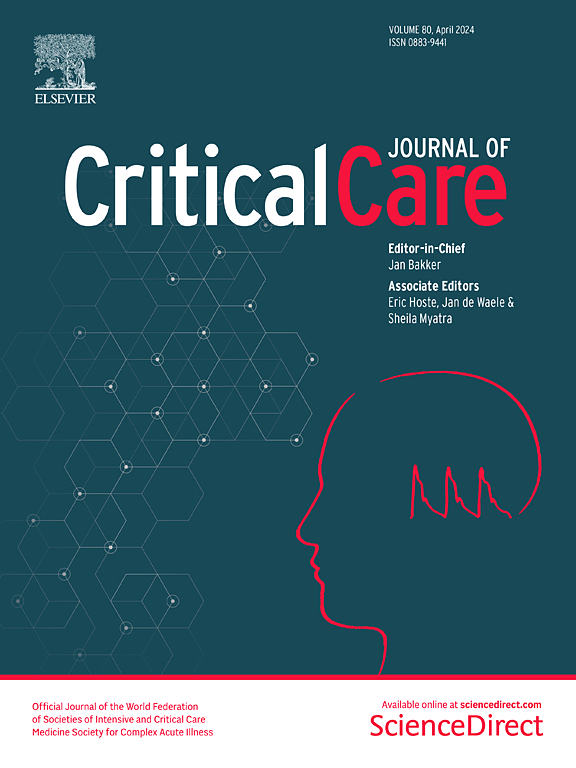机器学习模型与当前临床指标比较,预测急性低氧性呼吸衰竭患者高流量鼻插管治疗的结果
IF 8.8
1区 医学
Q1 CRITICAL CARE MEDICINE
引用次数: 0
摘要
早期识别有高流量鼻插管(HFNC)治疗失败风险的急性低氧性呼吸衰竭(AHRF)患者可以促进更密切的监测,并及时调整/升级治疗。我们的目的是确定机器学习(ML)模型是否可以在治疗早期预测HFNC的结果,比目前使用的临床指标更准确。我们开发了ML模型,使用2018年至2023年在摩德纳大学医院呼吸ICU治疗的184例AHRF患者(37% HFNC失败)在治疗前2小时内进行的测量进行训练。为了进行外部验证,我们使用了567例AHRF患者(22%失败)的数据集,其中510例来自巴西最近的RENOVATE试验,57例来自美国的MIMIC-IV和eICU数据库。ML模型的预测性能以以下临床指标的优化阈值为基准:呼吸速率氧合指数(ROX)和变异、心率与脉搏氧饱和度(SpO2)比、SpO2/FiO2比、PaO2/FiO2比、序贯器官衰竭评估和心率、酸中毒、意识、氧合和呼吸速率评分。支持向量机(SVM) ML模型的内部和外部预测性能优于所有临床指标。在567例患者数据集的外部验证中,非侵入性测量训练的SVM模型准确率为73%,灵敏度为73%,特异性为73%,AUC为0.79。ROX指数的准确度为64%,灵敏度为79%,特异性为60%,AUC为0.74。当动脉血气(ABG)也用于模型训练时,SVM模型在MIMIC-IV/eICU数据集上的外部验证准确率为83%,灵敏度为84%,特异性为82%,AUC为0.82。改进的ROX指数,需要PaO2,准确度达到70%,灵敏度63%,特异性74%,AUC为0.65。基于支持向量机模型的决策支持工具可以为临床医生提供比现有临床指标更准确的HFNC预后早期预测。如果可用,ABG测量可以提高准确识别HFNC治疗失败风险患者的能力。本文章由计算机程序翻译,如有差异,请以英文原文为准。
Machine learning models compared with current clinical indices to predict the outcome of high flow nasal cannula therapy in acute hypoxemic respiratory failure
Early identification of patients with acute hypoxemic respiratory failure (AHRF) who are at risk of failing high-flow nasal cannula (HFNC) therapy could facilitate closer monitoring, and timely adjustment/escalation of treatment. We aimed to establish whether machine learning (ML) models could predict HFNC outcome, early in the course of treatment, with greater accuracy than currently used clinical indices. We developed ML models trained using measurements made within the first 2 h of treatment from 184 AHRF patients (37% HFNC failures) treated at the respiratory ICU of the University Hospital of Modena between 2018 and 2023. For external validation, we used a dataset on 567 AHRF patients (22% failures) comprising 510 patients from the recent RENOVATE trial in Brazil and 57 from the MIMIC-IV and eICU databases in the US. Predictive performance of the ML models was benchmarked against optimized thresholds of the following clinical indices: respiratory rate oxygenation index (ROX) and variants, heart rate to saturation of pulse oxygen (SpO2) ratio, SpO2/FiO2 ratio, PaO2/FiO2 ratio, sequential organ failure assessment and heart rate, acidosis, consciousness, oxygenation and respiratory rate scores. Internal and external predictive performance of a Support Vector Machine (SVM) ML model was superior to all clinical indices across all scenarios tested. In external validation on the 567-patient dataset, a SVM model trained on non-invasive measurements had an accuracy of 73%, sensitivity of 73%, specificity of 73%, and AUC of 0.79. The ROX index had an accuracy of 64%, sensitivity of 79%, specificity of 60%, and AUC of 0.74. When arterial blood gasses (ABG’s) were also used for model training, the SVM model had an accuracy of 83%, sensitivity of 84%, specificity of 82%, and AUC of 0.82 in external validation on the MIMIC-IV/eICU dataset. The modified ROX index, which requires PaO2, achieved 70% accuracy, 63% sensitivity, 74% specificity, and AUC of 0.65. Decision support tools based on SVM models could provide clinicians with more accurate early predictions of HFNC outcome than currently available clinical indices. If available, ABG measurements could improve the capability to accurately identify patients at risk of failing HFNC therapy.
求助全文
通过发布文献求助,成功后即可免费获取论文全文。
去求助
来源期刊

Critical Care
医学-危重病医学
CiteScore
20.60
自引率
3.30%
发文量
348
审稿时长
1.5 months
期刊介绍:
Critical Care is an esteemed international medical journal that undergoes a rigorous peer-review process to maintain its high quality standards. Its primary objective is to enhance the healthcare services offered to critically ill patients. To achieve this, the journal focuses on gathering, exchanging, disseminating, and endorsing evidence-based information that is highly relevant to intensivists. By doing so, Critical Care seeks to provide a thorough and inclusive examination of the intensive care field.
 求助内容:
求助内容: 应助结果提醒方式:
应助结果提醒方式:


